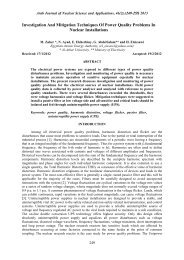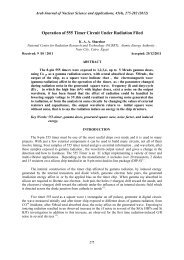Download - Arab Journal of Nuclear Sciences and Applications
Download - Arab Journal of Nuclear Sciences and Applications
Download - Arab Journal of Nuclear Sciences and Applications
You also want an ePaper? Increase the reach of your titles
YUMPU automatically turns print PDFs into web optimized ePapers that Google loves.
<strong>Arab</strong> <strong>Journal</strong> Of <strong>Nuclear</strong> Science And <strong>Applications</strong>, 46(2), (276-286) 2013<br />
was, thus, important to survey over the available turbulence models in terms <strong>of</strong> their criteria <strong>of</strong><br />
applicability, limitations <strong>and</strong> restrictions in order to choose the one that might be appropriate to model<br />
this complex system. Moreover, literature surveys were conducted to explore on what other researcher<br />
have recommended for similar systems. It was found that substantial amount <strong>of</strong> research work have<br />
been done on rod bundle geometry using the st<strong>and</strong>ard k turbulence models over the past few<br />
decades for a recent in-depth review on CFD analysis on rod bundle geometries ( Tzanos 2001 (1) ). In<br />
general, there is a great deal <strong>of</strong> agreement between researchers that the st<strong>and</strong>ard k model may not<br />
be the turbulence model <strong>of</strong> choice in rod bundle geometries. On the other h<strong>and</strong>, most <strong>of</strong> these<br />
researches have considered periodic arrays <strong>of</strong> rods which allowed them to solving the flow in<br />
elementary sections <strong>and</strong> assuming symmetry across the boundaries (Rapley <strong>and</strong> Gosman 1986 (2) ;<br />
Baglietto <strong>and</strong> Ninokata, 2005 (3) ; <strong>and</strong> many others). However, as Chang <strong>and</strong> Tavoularis, 2007 (4) pointed<br />
out, this approach restricts the solution based on the fact that symmetry in geometrical configurations<br />
does not necessarily imply symmetry in the flow. In other words, simulating a full sector may be<br />
required to better capture the essential features <strong>of</strong> the flow field. It was reported the use <strong>of</strong> the shearstress<br />
transport (SST) k <br />
model to perform CFD analysis <strong>of</strong> flow field in a triangular rod bundle<br />
by Toth <strong>and</strong> Aszodi (2008) (5) . Chang <strong>and</strong> Tavoularis, 2005 (6) , on the other h<strong>and</strong>, used the unsteady<br />
Reynolds averaged Navier-Stokes equations supplemented by a st<strong>and</strong>ard Reynolds stress model to<br />
simulate the experimental work <strong>of</strong> Guellouz <strong>and</strong> Tavoularis 2000 (7) a,b <strong>and</strong> reported good agreement.<br />
In this work, we consider the use <strong>of</strong> the shear-stress transport (SST) <br />
Toth <strong>and</strong> Aszodi, 2008 (5) . Moreover, the two approaches to dealing with the near wall region were<br />
considered with the aim that if it is founded that the wall function approach provides reasonable<br />
approximation to the measured inner clad surface temperature, then it might be recommended for<br />
further investigation since it usually requires less computing resources.<br />
2-The Shear-Stress Transport (SST) <br />
k model<br />
281<br />
k model as suggested by<br />
k <strong>and</strong> SST models, which are basically two equation eddy-viscosity models, the<br />
In both the <br />
Reynolds stresses can be calculated from the eddy-viscosity hypothesis introduced by Boussinesq,<br />
(Pope, 2000 (8) ):<br />
2 <br />
<br />
U<br />
uiu j k<br />
ij <br />
t<br />
3 <br />
<br />
x<br />
j<br />
i<br />
U<br />
<br />
x<br />
i<br />
j<br />
<br />
<br />
<br />
<br />
As suggested by Menter, if it is possible to combine the st<strong>and</strong>ard <br />
shows to be relatively accurate if applied to the near wall region with the <br />
accurate in the far field, one may obtain a model that may be used in a variety <strong>of</strong> applications<br />
involving confining walls. This model is called the shear-stress transport <br />
basically the same formulation as the st<strong>and</strong>ard <br />
activate the <br />
region. In addition the definition <strong>of</strong> turbulent viscosity is modified to account for the transport <strong>of</strong> the<br />
turbulent shear stress.<br />
(1)<br />
k model, Wilcox, which<br />
k model which is also<br />
k model. It has<br />
k model but it includes blending function to<br />
k model in the near-wall region or the transformed <br />
k away from the wall<br />
In this model, the turbulent kinetic energy, k, <strong>and</strong> the specific dissipation rate, , may be<br />
obtained from the following transport equations (FLUENT, 2006 (9) ):<br />
k<br />
~<br />
( k)<br />
( kui<br />
) (<br />
k<br />
) Gk<br />
Yk<br />
S k<br />
(2)<br />
t<br />
xi<br />
x<br />
j <br />
x<br />
j












